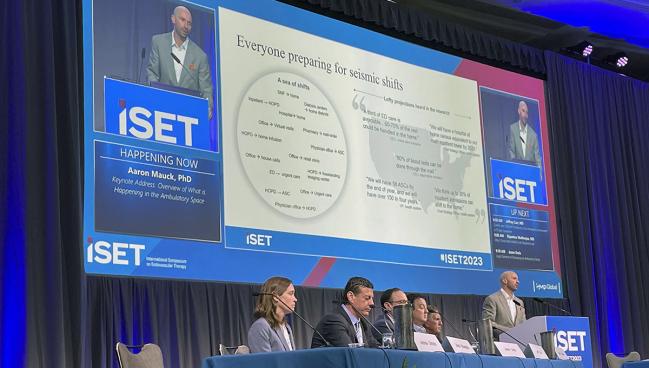Advent of Outpatient Endovascular Care Part of a ‘Sea Change’ in Medicine
Numerous factors—money, convenience, control—are driving the shift, but ISET presenters agreed nothing’s set in stone.

MIAMI BEACH, FL—Endovascular procedures are increasingly performed not in hospitals but in outpatient settings, a shift driven by numerous factors including money to be saved, convenience for patients, and a fresh start for healthcare professionals who are ever more burnt out by medicine’s demands.
The momentum has grown to the point that this year organizers of ISET 2023 dedicated a nearly 2-hour Town Hall to the topic. Presenters gave their takes on best- and worst-case scenarios, with an eye toward what is propelling both the field and physician behavior.
“Obviously,” said Aaron Mauck, PhD (Advisory Board, Washington, DC), who delivered the session’s keynote address, what’s happening in endovascular interventions “is just one element of a much broader sea change that we see taking place in healthcare overall.” Projections about how much medicine will move beyond the hospital have been “lofty,” perhaps to an unrealistic degree, he added. “The last 2 or 3 years of COVID have accelerated some of these dynamics, but also have accelerated [people’s] expectations about just how much care is going to shift, and how quickly it’s going to shift.”
Mauck said the drivers of this evolution fall into four main categories: policy and regulation, purchaser preference, innovation, and provider competition. Beyond traditional factors like the Medicare fee schedule and joint ventures among facilities, more-recent arrivals include expansion of insurance coverage for telehealth, perceived in-person infection risks, and pandemic-related hospital staff burnout.
Their combined impact is such that in the next 5 years—“a relatively short timeline to see such a rapid increase”—the volume of vascular care done in outpatient settings will rise by 12%, Mauck predicted, particularly office-based labs (OBLs) but also ambulatory surgery centers (ASCs) and hospital-based outpatient departments. This reflects both increasing demand posed by an aging population as well as a growing ability to perform procedures beyond the hospital confines.
At the same time, inpatient vascular care is set to drop by just 1%, “primarily because inpatient procedures for vascular are essentially ‘right sized.’ They’re where they’re going to stay unless we see some radical change in available technologies for what can be done,” he explained.
Growth Uneven and Not Guaranteed
But these shifts are not consistent, Mauck noted. Thanks to differences in market and regulatory dynamics, “there’s a heck of a lot of variation across individual [US] states.” An example are Certificate of Need (CON) laws, which in some states require those opening new healthcare facilities to define what gap they are trying to fill.
There is in fact demand, as noted by a 2019 TCTMD investigation into the potential benefits and harms of peripheral vascular interventions in the outpatient setting; the story later won the 2020 Trade Journalism Award from the National Institute for Health Care Management.
Investors, for one, are eager to get into the outpatient space. “No private equity is buying a hospital. They’re interested in making capital investments where there is big bang for the buck, and from their perspective the biggest bang for their buck is in [ASCs and OBLs],” he commented. Entities like health plans, employers, and other purchasers hope to save money by prioritizing providers than offer freestanding options. “Now, ideally, they want very low-cost, very high-quality procedures,” said Mauck. “Frankly, they’d settle for low-cost procedures.
Growth in the outpatient area, though, also hinges on having enough physicians who want to work in that environment—something that has become more and more plausible with the rise of COVID-19 burnout.
We’re not fully out of the days of it being the Wild West. Aaron Mauck
Hospitals are “an exhausting space to work in,” Mauck said, but this hasn’t inspired people to quit medicine entirely. “When we look at the healthcare space broadly, we have not seen a wholesale ‘Great Resignation’ of folks away from healthcare. That’s true even for nurses. What we have not seen is waves upon waves of retirement, with people just leaving the profession as a whole,” he noted. “What we have seen is something closer to a ‘Great Realignment,’ a shift away from certain kinds of care environments towards others. This may have an accelerating effect on the ambulatory space.”
In this regard, hospitals and postacute care facilities have been hit hard, said Mauck, while outpatient and virtual providers, as well as “big tech, big retail, and startups” have made gains.
Yet the future “is by no means etched in stone,” he cautioned.
The US Centers for Medicare & Medicaid Services (CMS) continues to change what they will—and won’t—reimburse. The agency decided to cover PCI done in ASCs as of 2020, for instance. In 2021, they extended coverage to PCI for higher-complexity subgroups (chronic total occlusions, bypass grafts, atherectomy), which they then rescinded the following year. On a state level, laws may continue to require CON, and as detailed by the TCTMD investigation, concerns abound about the poor outcomes that can occur when it feels like no one is watching (this despite the fact that OBLs and ASCs have begun to face growing scrutiny from regulators).
Although efforts like the Outpatient Endovascular and Interventional Society (OEIS) National Registry and Vascular Quality Initiative (VQI) have begun to take root, “we’re not fully out of the days of it being the Wild West. If you look 10 years ago, we just didn’t have any data. It was very challenging. We’re moving out of that time period, but we’re still going to need more data,” said Mauck, noting that if these show “outcomes being less than ideal,” there are policy implications.
Safety Paramount
Jeffrey Carr, MD (CardiaStream, Tyler, TX), founder and past president of the OEIS, and the medical director of its registry, said that in the outpatient setting “there’s nothing more paramount than ensuring safety.”
To maintain the best outcomes requires forethought, stressed Carr. It involves the right tools on hand (eg, closure device, ultrasound guidance, distal embolic protection, intra-aortic balloon pumps, vasopressors, and thrombolytics) and making sure the right processes are in place (eg, emergency transfer agreements, credentialling, patient risk assessment, and bailout drills).
Definitely top on my list was control—I want to control my schedule, and I want to control the care of my patients. Jeffrey Carr
Carr told the ISET audience he and his colleagues had several reasons for deciding 15 years ago to open an OBL. As a physician, “definitely top on my list was control—I want to control my schedule, and I want to control the care of my patients,” said Carr. Other benefits are that “physicians, staff, and business models are all aligned, and it offers control over quality of patient care, staffing, and product choices,” he said, noting that while there was the potential for revenue, there also was financial risk.
Their facility, Tyler Cardiac & Endovascular Center, went a step further in 2014 to become a hybrid OBL/ASC. Because procedures are reimbursed differently in each type of facility, this allows them to diversify what treatments they provide and minimize the effects of cuts by CMS and commercial payers. Additionally, it helps them aim higher in terms of quality, because the requirements for operating an ASC are more stringent than they are for an OBL.
In his opinion, said Carr, “the future is very bright for expanding procedures, reducing costs, and creating high value in the office-based and ASC settings.”
Where Outpatient Can Go Wrong . . . and Right
Dipankar Mukherjee, MD (INOVA Fairfax Hospital, Falls Church, VA), however, falls on the opposite end of the spectrum. In his presentation, a counterpoint to the enthusiasm for outpatient care, he sounded a cautionary note.
He began by citing research showing a surge in peripheral vascular interventions, perhaps due to overuse and driven by a shift toward outpatient settings. As reported by TCTMD, atherectomy use spiked at nonhospital facilities when Medicare began paying for it, with other data showing these office-based procedures had worse outcomes. Moreover, Mukherjee’s own research using the VQI data set has found that for patients with claudication, atherectomy didn’t offer any survival advantage over balloon angioplasty alone. Nor does intermittent claudication, according to guidelines, justify intervention in most cases.
“What had been good for the bottom line of the [providers] was not so good for the patient,” he commented.
CMS spent nearly $267 million in reimbursement for femoropopliteal interventions in 2019, he said, of which 90% was for atherectomy—a technique used in only 54% of cases, he pointed out. “How can this be justified? Unsavory practices that are ongoing in the OBL is not a perception but a reality,” spurred in part by higher reimbursement for atherectomy compared with angioplasty and stenting.
Therefore, “the rules of the game” in terms of how procedures are compensated for need to change, both from an ethical standpoint and from the perspective of education, he said, implying that the shift of interventionalists away from the hospital will impact the next generation’s education and skills.
Unsavory practices that are ongoing in the OBL is not a perception but a reality. Dipankar Mukherjee
Bret N. Wiechmann, MD (Vascular & Interventional Physicians, Gainesville, FL), current president of the OEIS, believes oversight will ensure better care.
Yet in a nonhospital environment, where heterogeneity rules, establishing that can prove challenging, Wiechmann said. “If you want to have oversight of your entity, where do you go? Who’s job is it? And is there real authority—does anybody in the office-based space or ambulatory surgery space really want to duplicate the Joint Commission? I mean, that’s a painful process and once every 3 years everybody’s on their best behavior in a hospital.”
Tracking outcomes is, of course, one way to assess quality. The OEIS National Registry launched its peripheral vascular module in 2017. Today, he reported, it includes more than 37,000 procedures done in more than 23,000 patients, with an overall complication rate of 2.1%. Participants in the registry get access to a “dashboard” with these data that “allows benchmarking against certain standards,” he said, noting a cardiac module is being developed.
Additionally, OEIS had been in the planning stages with a large accreditation body to create official standards for nonhospital settings, though that initial effort failed, Wiechmann said.
“It was a lengthy process, very expensive, and just like anytime you’re dealing with a multilevel bureaucracy things fall short. . . . It really fell apart due to [debates over] who was going to ‘own’ the process, but it doesn’t mean that we’re not going to continue to make efforts in that regard,” he stressed, adding, “You go back to the drawing board and start again.”
Caitlin E. Cox is News Editor of TCTMD and Associate Director, Editorial Content at the Cardiovascular Research Foundation. She produces the…
Read Full BioSources
Various presentations: ISET Townhall: Movement of endovascular procedures to the ambulatory space. Presented at: ISET 2023. January 17, 2023. Miami Beach, FL.
Disclosures
- Mauck reports being an employee of United Healthcare.
- Carr reports being medical director of the OEIS National Registry and a board member of the Cardiovascular Coalition.
- Mukherjee reports no relevant conflicts of interest.
- Wiechmann reports serving on the advisory boards of BD and Boston Scientific Corporation, as well as being a consultant to AngioDynamics and Boston Scientific Corporation.





Comments